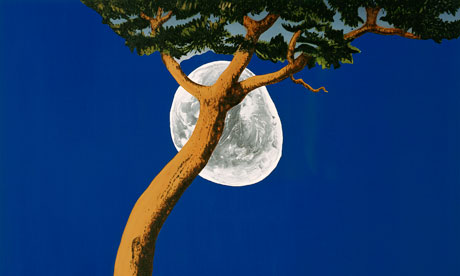The death of Dr David Kelly imagined in paint, a haunting Scottish lament heard beneath the bridges of the Clyde and a history of the present told as if by a voyager on the Soviet space station in 2103 – all these are works by the artists on a lyrical, melancholic, even elegiac shortlist for the 2010 Turner prize.
And, despite the great popularity of the Banksy exhibition in Bristol last year, his fans will be disappointed. Although enthusiasm for his work was expressed publicly by one of the judges, Andrew Nairne, the street artist has not made the shortlist.
Dexter Dalwood is the artist whose work titled The Death of David Kelly might draw comparisons with hefty history paintings such as David's magisterial The Death of Marat, which depicted the revolutionary journalist's corpse in his bath after he was killed by Charlotte Corday.
Dalwood's painting, however, is quite different. It shows a tree backlit by the moon atop a little mound: an imagined vision of the scene of the weapons expert's death rather than a depiction (perhaps mercifully) of his suicide in 2003.
Dalwood, 49, has also made works called Greenham Common and Brighton Bomb, constructing scenes from descriptions in the media and exercising his theory that "history is a construction, a fiction ... I am constructing histories from a necessarily subjective view, which is no more or less real than any of the other attempts to describe that time or event".
The titles of his works, said the novelist Philip Hensher, one of the jurors for the £25,000 prize, are "tantalising", referring to paintings such as The Queen's Bedroom and Sharon Tate's House. Recent years have seen "an overt political commitment" surfacing amid the artist's interest in celebrity, according to Hensher.
This year's shortlist is unusual because it includes two painters. Angela de la Cruz, 45, a Spanish-born artist who distorts, rips, breaks and crushes her canvases to the point where they resemble sculptures as much as paintings. "She has a great love of material textures, of rich messy surfaces and complicated forms. They carry great emotional weight and they are a sheer pleasure to look at," said Hensher.
If what draws together all four shortlisted artists for the prize is melancholia and wistfulness for the past, then those qualities are particularly present in the work of Susan Philipsz, the Scottish sculptor who was once rejected by Glasgow School of Art (but accepted at Dundee).
Philipsz, 44, has been nominated for, among other works, a sound installation recently created for the Glasgow International Festival of Visual Art. Beneath three of the Clyde bridges, passers-by could catch recordings of Philipsz singing a 16th-century Scottish lament called Lowlands Away.
Catching people unawares under the bridges, the sound had a haunting, mysterious lilt: Philipsz's work draws on "loss, longing and the power of memory", according to judge Polly Staple, the director of the Chisenhale gallery in London.
Philipsz is particularly adept at finding curious and evocative sites for her sound pieces, which invariably consist of recordings of her own pleasant, but untrained, singing voice. For an exhibition in Spain last year, a recording of her singing Syd Barrett's song Long Gone was heard by visitors entering the museum. She has also made pieces for supermarkets, bus stations and underpasses; her singing "acting as an emotional trigger for artists to reflect on their own sense of being".
Penelope Curtis, the director of Tate Britain, said today that organisers would be "flexible" if Philipsz wanted to make a piece for the Turner prize exhibition using a space other than the rooms reserved for the show.
The final name on the shortlist is that of the Otolith Group, which consists of Kodwo Eshun, 44, and Anjalika Sagar, 42. Neither is a trained artist – Eshun studied English at Oxford University and Sagar read anthropology and Hindi at the University of London.
Working primarily in film, the group – whose name comes from the term for the part of the inner ear that senses tilt – has delved into forgotten archives to uncover hidden histories, or stories of what might have been. Their film Otolith 1 imagines a world with humans, ill-adapted to gravity on Earth, who exist on space stations; it is narrated by Dr Usha Adebaran-Sagar in 2103, who reports on the present from her perspective far in the future.
The Turner prize exhibition at Tate Britain opens on 4 October 2010. The winner will be announced on 6 December 2010.









